3 steps to bridging the competency gap for HSE risk management professionals
By Linda Hsieh, managing editor
The drilling industry is placing increasing demands on HSE risk management professionals, yet training and education for this relatively new profession are not keeping pace and has resulted in a competency gap, Risktec Solutions director Gareth Book said last week at the 2011 IADC Critical Issues Asia Pacific Conference in Kuala Lumpur. “The competence gap arises when there is a mismatch between the knowledge and skills that individual has and the judgments that they are required to make as part of their job role,” he explained.

To bridge this gap, Mr Book proposes three steps. First, tailor the training. “One size does not fit all. Make sure the training addresses real risks relevant to the drilling industry and, more importantly, to the individual’s job role,” he said. Practical, hands-on exercises based on real-life drilling case studies would be more effective than off-the-shelf training that may not be industry-specific, as well as academic study, which may be too removed from industry-specific day-to-day realities.
Second, obtain qualifications. Getting a qualification requires an assessment of learning, ensuring that information wasn’t simply spoon-fed to the student during training; it also encourages active participation. “From the company’s perspective, a recognized qualification demonstrates a clear investment in its employees and contributes to professional development,” Mr Book said.
Third, help HSE risk management professionals to really understand drilling-specific issues. They should have at least a working knowledge of the technical and regulatory issues that are facing the drilling industry, Mr Book explained.
Because there are still very few first degrees available in HSE risk management, industry must work harder at providing new recruits with the knowledge and skills they need to deal with the growing technical challenges that accompany drilling in harsher environments and the adoption of new drilling technologies. “As we become more reliant on these new technologies or as we address these technical challenges, we also need to manage the HSE risks associated with them. That introduces a whole set of new risk management competencies that HSE professionals within the drilling industry may not have had to deal with before,” he said.
“The role of a competent HSE risk management professional is really to help an organization by providing advice, which helps the organization make the right risk-based decisions at the right time,” Mr Book noted. He stressed that they need to be equipped to challenge the status quo in the way risk is managed, and draw on their own judgment based on their competencies to interpret results of risk assessments and implement improvements.
Risk management professionals can be called upon to make or support a broad spectrum of judgments within the drilling industry, ranging from occupational hazards to major accident hazards. “This is why competency of HSE risk management professionals is extremely important,” Mr Book said.




